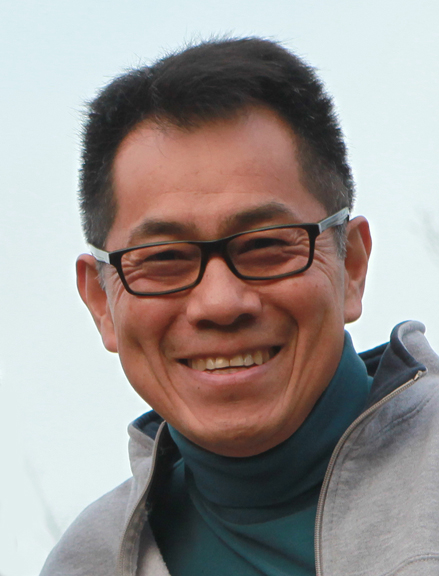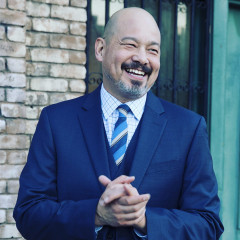Entertainment Spotlight
Actor Tim Lounibos - Hopeful Opportunities Ahead for APA's in Hollywood Movies and Television
Award-winning documentary filmmaker Arthur Dong shares insights into his art of filmmaking with Suzanne Joe Kai
Updated March 28, 2012
Congratulations to documentary filmmaker Arthur Dong. Arthur has also been awarded in March, 2012 a grant from the California Council for the Humanities for his documentary project on the late Cambodian actor Haing Ngor. On December 1, 2011 The National Endowment for the Humanities (NEH) also awarded him a research and development grant for the same documentary project. Congratulations!
Arthur shared insights into his art of documentary filmmaking with AsianConnections, and details on his latest projects.
Suzanne: Arthur, thank you for sharing with our audience updates on your current projects.
Arthur: I’ve got a few projects working their way up to the front burners.
First, I’ve just been granted exclusive documentary rights to the life story of Dr. Haing S. Ngor, the first-time actor in The Killing Fields who drew upon his four-year interment in Khmer Rouge prison camps to create an Oscar-winning performance. Dr. Ngor is mostly known for his film work, but what I find compelling is his quest to bring worldwide attention to the devastation of Cambodia under the Pol Pot regime.
In Cambodia, he is a folk hero; in America, he’s a role model. Unfortunately, Dr. Ngor was murdered in 1996 in L.A.’s Chinatown. Although the case was officially solved and convicted as a botched robbery, it’s still a mystery to many in the Cambodian community. In fact, in 2009, at the Cambodian tribunals to bring top members of the Pol Pot regime to justice, Kaing Guek Eav (alias Duch), the notorious warden of Tuol Sleng torture camp, claimed “Haing S. Ngor was killed because he appeared in the film The Killing Fields.” That was a chilling statement. It reverberated with Cambodians worldwide and their scarred memories of Khmer Rouge guards who ravaged their country re-surfaced. For the documentary project, I’ve also optioned Dr. Ngor’s autobiography, Surviving the Killing Fields, and will use it as we develop the script.
Secondly, after 22 years, I’ve finally started on my book that combines oral histories and an essay with visual graphic materials from the research archives of my 1989 film, Forbidden City, U.S.A, a documentary on the Chinese American nightclub scene in World War II San Francisco. During the documentary’s research period, I amassed a vast array of ephemera that traces the images and experiences of Chinese Americans on American nightclub stages during the 1930s and into the 50s. I also interviewed, on over 100 hours of tape, over 25 participants from the era, covering their personal stories as well as the social conditions under which they worked. I was only able to include a fraction of this material in my documentary. Many of the stories and artifacts in my collection have not been heard or seen since the 1930s and my book will present them in book form. It will feature the lives and work of artists who have triumphed as well as struggled with an entertainment industry often ignorant of race. Most of all, it’s going to be fun and glamorous, with brassy, in-your-face, showbiz images of personalities in tuxedos, furs, zoot suits, feather boas, evening gowns, and yes, even birthday suits!
Lastly, I’m enjoying being a dad, and above all else, that’s my real full time job!
Suzanne: Congratulations on being a Dad! I agree that is a full time job and a wonderful one!
Can you share some insights into how you approach a documentary film project. Do you start with a concept, then research, and develop a treatment and then shoot and edit the film, or do you approach your films differently?
Arthur: I’ll start my projects with a story and then a lot of research. I really delve into finding out as much as I can about a topic so, even though I may not use the knowledge in the actual film, I’ll have a foundation. I then formulate a story and plotline that will carry the film, knowing that in the editing room I’ll want a lot of room for discovery. After putting together the treatment, I’ll shoot and edit, allowing for surprises along the way. Editing is my favorite part of the filmmaking process. For me, that’s where the magic finally comes together, and if I’ve done my job, I’ll see the rewards.
Suzanne: What drives you forward to write, direct and produce your films year after year? They are all great films.
Arthur: I love filmmaking and am just really lucky that I’ve been able to carve out a career doing something that isn’t like work at all. I mean, of course filmmaking is a lot of work, but I’m really energized when I’m deep into a project and I can’t wait to wake up each day to get going. As I mentioned, I’m writing a book now and that’s been a wonderful creative challenge as well.
Suzanne: When do you know your film is ready to be screened by the public?
Arthur: Hum, no one’s ever asked me that before. I have to think... I’m really meticulous and would go over each and every frame before I’m satisfied. I make my films for large audiences, but at the same time I’m making a film for myself too. In the final stages of editing, I’d run the work-in-progress non-stop as a way to gauge the temporal rhythm of the film and to note any “hic-cups.” And anything can cause a hic-cup: story gaps, cuts that don’t work, scenes that are incomplete, unresolved questions, music cues, and so on. I also watch my work-in-progress on different sized screens because I know that the film will eventually be seen in a range of venues, from portable TVs to large movie houses, and now cell phones, and I want to make sure it works in all these environments. I go through this process many, many times, and when I can finally sit through a film without taking a note, that’s when I feel it’s ready. That’s not to say that I haven’t felt like I’d like to change something later after a film’s been done for a while. But I’ve been pretty accepting that a film gets finished and that it represents my vision at the time of its completion.
Given that, last year I actually re-edited my 1980 film, Living Music for Golden Mountains. It was student film about my Chinese music teacher. Although I was the director, it was a film school class project done under really scant production conditions and a worst-than-meager budget. The film was mostly in Chinese and we had very, very little money for subtitles. I was also intrigued at the time with the technique of uninterrupted long takes. That’s well and good as a concept to explore while in film school and to apply when appropriate, but I don’t think it worked for the film. For the new edit, I cut out 9 minutes out of its original 27, and put in new subtitles and an epilogue. I included it in a compilation DVD titled, A Toisan Trilogy, (http://deepfocusproductions.com/toisan_trilogy.php) which includes my other two short films, Sewing Woman and Lotus. All of this is in my DVD box-set, Stories from Chinese America ( http://deepfocusproductions.com/stories_from_chinese_america.php ).
Suzanne: Can you share insights for independent filmmakers on raising funds in these tight economic times? Your thoughts on crowdfunding sources like IndieGoGo.com, and Kickstarter.com?
Arthur: Fundraising is a tough one — and it’s been tough for as long as I can remember! And I have to admit, like many artists, it’s my least favorite part of the creative process. The internet has transformed what we used to do person-to-person, that is, organize benefit parties or approach people with phone calls or letters of appeal. So crowdfunding via the internet is a great help to independent filmmakers who want to raise money from their fan base and individual supporters. Foundation grants are still out there, although the ratio of applicants-to-grants has risen. But foundations also have their specific goals and criteria, and it’s not always possible for projects to fit in. So crowdfunding can really play a key role in getting a project started. I haven’t tried it yet, but I hear from colleagues who have, and the reports I get are that your level of success will depend on how much work you put into the effort. In other words, it’s work!
Suzanne: Thank you very much for sharing your insights. Best wishes on your latest projects.
Arthur Dong's Official Website: www.DeepFocusProductions.com
Arthur Dong has received numerous awards for his films including a nomination for an Academy Award for Documentary Short Subject in 1984 for Sewing Woman, a Peabody Award in 1995 for Coming Out Under Fire, A Golden Horse Award for Best Documentary in 2007 for Hollywood Chinese, three Sundance Film Festival Awards, and five Emmy nominations.
Dong's first film, a 5 minute short shot on Super 8 while in high school, titled "Public" tells the story of a child’s response to oppressive societal norms and the culture of violence surrounding him.
The five-minute film earned first prize at the California High School Film Festival and was the young filmmaker’s first introduction to the power of film as a tool for progressive change. In his award-winning films since then, Dong has continued to combine the art of the visual medium with an investigation of social issues.
In 2010, Dong released his second DVD collection, “Stories from Chinese America.” It includes the collector’s edition of his two feature documentaries: Hollywood Chinese (2007), a landmark examination of the Chinese in American feature films and Forbidden City, U.S.A., a ground-breaking account of the Chinese American nightclub scene during World War II. The box set also features three earlier short films that comprise A Toisan Trilogy, which includes Sewing Woman, the Oscar®-nominated documentary based on the filmmaker’s mother; Lotus, a fictionalized film exploring the conflicts over footbinding; and Living Music for Golden Mountains, Dong’s 1981 documentary directorial debut profiling his Chinese music teacher. In addition to the full-length versions of each film, Stories from Chinese America premieres the newly scored and restored 1916 film, The Curse of Quon Gwon, the earliest known Chinese American feature film that Dong helped rescue during his work on Hollywood Chinese.


